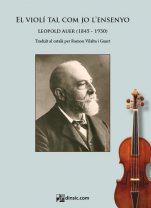El violí tal com jo l'ensenyo


Inside Pages
Author/Composer
Translator
Prologue
Field
Music Schools and Conservatoires Intermediate Level
Music Schools and Conservatoires Advanced Level
Musicography
Musical Pedagogy
University Level
Collection
Manuals universitaris Nr. 15
Language
Format
Book
Contents
......
During his prolific career as a violin player, orchestra conductor, composer, and, above all, as an academic and instructor, the Hungarian violinist Leopold Auer held the post of violin professor at the Saint Petersburg Conservatory from 1868 to 1917 leaving us with a huge musical legacy through his students, including some of the most well-known violinists of the twentieth century such as Jascha Heifetz, Misha Elman, Nathan Milstein and Efrem Zimbalist, among others.
This book begins with autobiographical notes to offer the reader an insight into the author’s musical education and his precocious development in becoming a great violinist, all explained in a delightful and attractive way. Auer then immerses us in a thorough sequence of rules and guidelines to take us, step by step, carefully through the learning process of how to hold the instrument and the positions of the hands. This ensures a solid technical base so the future musician can then express themselves freely in their music. As Auer stated, “Art begins where technique ends. That is, there can be no real art development before one’s technique is firmly established.” Jascha Heifetz, in an interview in 1925, quoted Auer as saying, “The one great point I lay stress on in teaching is never to kill the individuality of my various pupils. Each pupil has their own inborn aptitudes, their own personal qualities as regards tone and interpretation.” (The Sorcerer’s Apprentice: Leopold Auer and Jascha Heifetz, article published by Georg Predota in Interlude, 29 July 2020).
This universal multi-disciplinary encyclopaedia of violin-playing is carefully divided into different sections which explain the technique of using the bow from start to finish. It begins with how sounds are produced, with each possible kind of bowing movement. Auer then explains how to carry out all the possible techniques with the left hand, before describing how to study and practise. There are also extensive sections dedicated to the harmonics, nuances and phrasing of violin-playing and many other aspects to be taken into account.
.....
I believe that each musician belongs to a professional lineage made up of the choice of instructors and professors they have studied with. And this explains the special connection I feel with the author, as each one of my music teachers has been a descendant of the school of the great Leopold Auer.
Tatevik Khachatryan, violinist
Instruments
ViolinStructure
- I Com vaig estudiar el violí
- II Com s’agafa el violí
- III Com s’ha d’estudiar
- IV La producció del so
- V Consells sobre els cops d’arc
- VI Tècnica de la mà esquerra
- VII Dobles cordes – El trinat
- VIII Ornaments – Pizzicato
- IX Harmònics
- X Matisos – L’ànima de la interpretació. Fraseig
- XI Estil
- XII Els nervis i el violí
- XIII El repertori de violí d’ahir i avui
- XIV Consells pràctics de repertori
- Índex onomàstic
- Làmina El violí amb la nomenclatura de les seves parts (Termcat)
Technical Specifications
Measurements
14 x 20 cm, vertical
Binding
Paperback with flaps. Matt plastic-coated.
Number of Pages
212
ISBN
978-84-16623-87-7
Editor
DINSIC Publicacions Musicals









